Table of Contents
- What is the State of Marketing Automation?
- Market Value
- Marketing Automation Regional Analysis
- Why do Marketers Use Automation?
- What are the benefits of automation marketing?
- Marketing Automation Stats & Facts
- Marketing Automation Benefits
- Use of Marketing Automation
- Processes That Make Use of Automation
- ROI of Marketing Automation
- B2B Marketing Automation
- Email Automation
- Social Media Automation
- Marketing Automation Trends & Challenges
- Chatbot Automation is Used by One-third of Marketers
- Recent Developments
- Conclusion
- FAQ’s
What is the State of Marketing Automation?
Marketing Automation Statistics: Businesses can automate marketing campaigns and tasks through the use of technology in marketing automation.
Businesses can automate tasks like sending targeted ads, emails, or social media posts through marketing automation.
It analyses customer behavior and also tracks it. These tools permit businesses to modify their marketing messages and aim at the correct audience when they are set. They can efficiently foster leads as well.
A vast array of industries, B2B and B2C included, utilize marketing automation. Large companies with complex sales cycles would find this particularly useful in managing their customers.
Besides, it gives them the capability to automate tasks that would otherwise demand a tremendous amount of manual labor.
Market Value
By 2023, the global marketing automation market is expected to generate revenue of nearly 5.9 billion US Dollars. This value will more than double to $13.7 billion by 2030. Global marketing automation software will generate revenue of 5.4 billion US Dollars. This value will more than double to $11.2 billion by 2031.
The Global AI In Marketing Market size is expected to be worth around USD 214.0 Billion by 2033, from USD 20.0 Billion in 2023, growing at a CAGR of 26.7% during the forecast period from 2024 to 2033.
(Source: Statista, market.us)
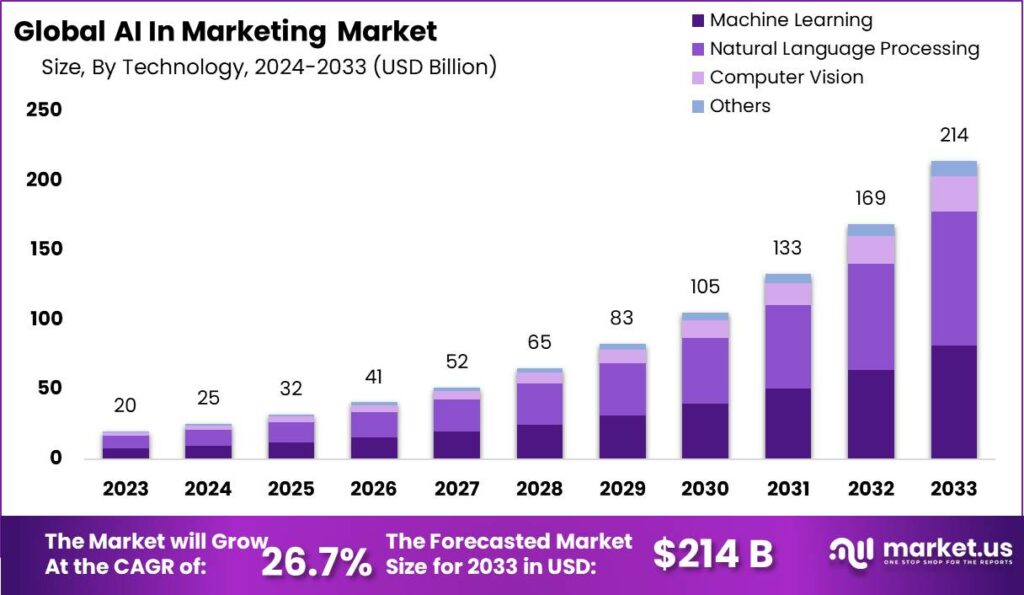
Marketing Automation Regional Analysis
North America is one of the most advanced regions in terms of marketing automation adoption. Marketing automation is a mature market in the region, with several developed vendors and an impressive rate of adoption among businesses of all sizes.
Europe: With a rapidly growing market, Europe is another important region for marketing automation. Marketing automation is being used by a large number of businesses in the region to improve marketing efficiency and effectiveness.
Asia-Pacific: Marketing automation adoption is increasing significantly in the Asia-Pacific region, with many businesses looking to automate promotional tasks. The number of marketing software vendors offering solutions in the region is also increasing.
Latin America While the Latin American market for automation marketing is still in its infancy, it’s growing rapidly. Marketing automation is being adopted by several small- and medium-sized companies in the region.
Middle East Africa Middle East & Africa is also in the early stages of marketing automation adoption. However, it is growing rapidly. In the region, many businesses are realizing the benefits of automation in marketing and are eager to adopt it.
Why do Marketers Use Automation?
In a survey of marketing decision-makers worldwide conducted in 2023, nearly 60% stated that they planned to increase their marketing automation spending for the coming year.
About 30 percent of respondents preferred to maintain the same level of spending. Marketers use this type of solution in many ways.
One of the most common uses is to manage leads, or potential clients that a brand may contact after obtaining some data. If a company automates this relationship, it can send more relevant messages and offers to consumers without having its staff do the work manually.
Respondents to the 2023 study stated that email, social media, and paid advertising are the three marketing channels most heavily automated.
What are the benefits of automation marketing?
A 2022 global study found that marketers see five major benefits in this process: improved customer experience, better time management, better data quality and decision-making, better lead generation, and nurturing and better budget use. This small but significant list has convinced many leaders, though to varying degrees of success.
Marketing Automation Stats & Facts
By the end of 2023, the worldwide advertising automation technology market is expected to be worth $25.1 billion.
The global automation for marketing market was worth $11.4 billion in 2017. Marketers gradually realized the benefits of marketing automation, and investments increased at a rate of $2 billion per year, reaching $15.6 billion by the end of 2019.
(Sources: Statista)
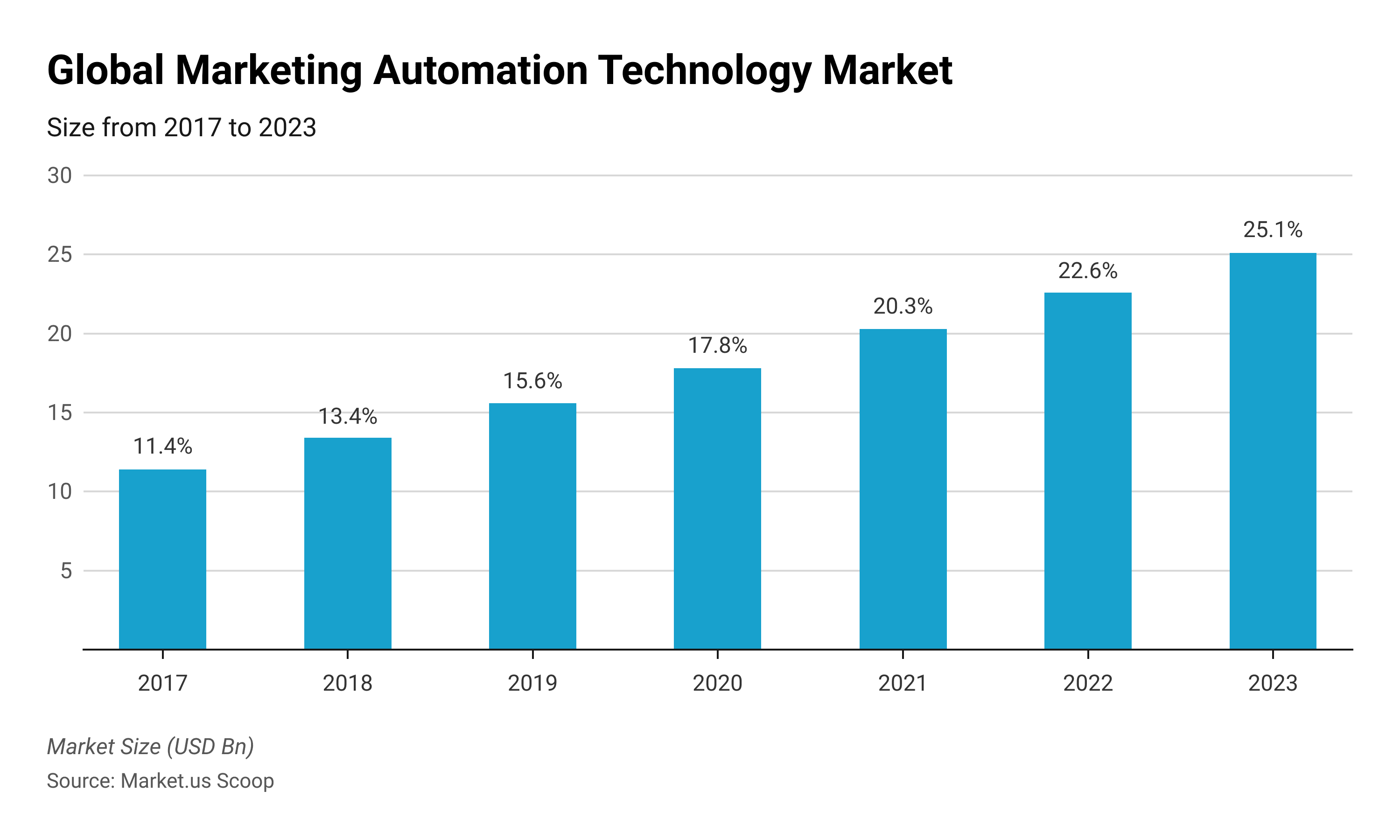
According to marketing automation statistics, three-quarters of businesses use some type of automation tool.
According to data, marketing automation tools have allowed 75% of businesses to focus on more important issues. Currently, only a quarter of businesses do not have a marketing automation strategy.
(Sources: Funnel Overload)
Marketing automation software is considered “essential” by 91% of marketers.
According to recent marketing automation statistics, the vast majority (91%) of marketers recognize the value and adaptability of such tools. Making investments in automated marketing frees up precious time in their busy schedules, allowing them to focus on other important aspects of their campaigns.
(Sources: InvespCRO)
HubSpot is the world’s leading provider of marketing automation solutions.
The HubSpot is the most widely used marketing automation solution. HubSpot is used by 29.51% of industry professionals worldwide. According to marketing automation industry statistics, Adobe Marketing Cloud ranks second with 12.11%, while Oracle Marketing Cloud ranks third with 8.63%. Active Campaign, Salesforce Pardot, Marketo, and other platforms are used all over the world.
(Sources: Statista)

90% of marketers use more than one type of marketing automation software regularly.
There are over 100 marketing automation platforms available. This type of software has become so popular and effective that the vast majority of marketers, or, according to marketing automation statistics, a staggering 90%, now use at least one such tool regularly. So, if you’re one of the last few people who isn’t already using campaign-saving automation tools, now is as good a time as any to start looking for the right fit.
(Sources: Learning Hub)
40% of marketers who do not currently use marketing automation intend to do so shortly.
Marketing automation statistics show that only about 10% of companies that have not yet implemented marketing automation have no plans to do so. Meanwhile, nearly half are unsure whether they would invest in such tools.
(Source: Funnel Overload)
The marketing automation software market is expected to reach $19.66 billion by 2026.
According to marketing automation software statistics, the market for marketing automation software is expected to grow from $6.87 billion in 2010 to $19.66 billion in 2026. Between 2021 and 2026, the registered CAGR will be 19.2%. Marketing automation is on the rise as the importance of marketing in generating sales and retaining customers grows. One of the fastest-growing industries is marketing automation software.
Over 60% of businesses outsource all or a portion of their marketing automation strategy planning.
According to marketing automation statistics, 37% of businesses today rely solely on in-house resources for this aspect of their operations. 12% would rather hire a specialist to handle this. According to industry trends, more than half (51%) of companies choose to combine in-house and outsourced resources for the task. Then, 11% of businesses believe marketing automation is too expensive, while 22% believe it is expensive but worthwhile. Nearly half of users (47%) believe the price is reasonable, and 10% believe it is not at all expensive.
(Source: Email Monday)
More than six in ten marketers intend to increase their marketing automation budget for the coming year.
According to the most recent marketing automation trends, satisfaction with using automation processes in marketing campaigns is increasing. Marketers adore this type of marketing because it saves time, increases customer engagement, allows for more timely communication, and, most importantly, provides better opportunities for both parties. As a result, 63% of marketers plan to invest more money in developing a more powerful automation strategy.
(Sources: InvespCRO)
Marketing Automation Benefits
Marketing automation increases qualified leads by 451%.
The generation of leads has always been one of the most sought-after marketing automation outcomes. According to sales automation statistics, businesses using software for marketing automation are twice as effective in lead generation as those that only use blast email software. Utilizing sales marketing automation programs gives your prospective clients the information they require not only to move down the sales funnel but also to make a purchasing decision. To put it another way, it shortens the sales cycle.
(Sources: Moosend)
Marketing automation is used by 61% of marketers to produce more leads.
The primary goal of using automation in marketing for the greatest number of marketers (61%), is to generate more leads. According to automation statistics, marketers are using marketing automation to maintain leads (57%), increase sales revenue (47%), and improve retention rates (36%), as well as marketing productivity (29%). As reported by 28% of marketers, automated marketing campaigns improve campaign measurability.
(Sources: Funnel Overload)
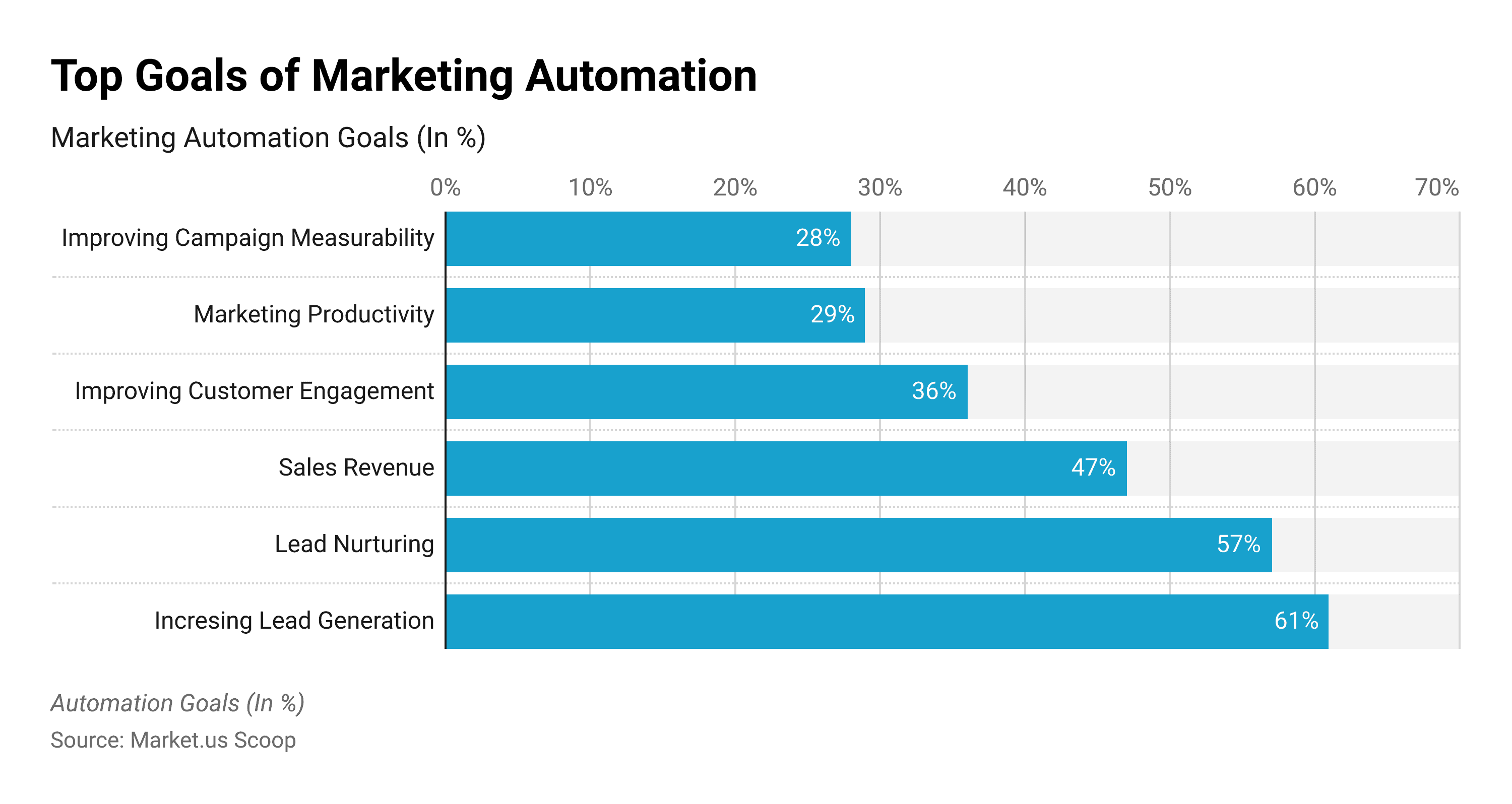
The most significant benefit of automation software, according to 74% of marketers, is time savings.
whereas saving time is a particularly major advantage of marketing automation, it is far from the only one, according to nearly all marketers (74%). Based on marketing automation data, 68% of marketers believe that marketing automation has a direct impact on customer engagement. Another direct benefit mentioned by 58% is more timely communication with customers. Finally, the same percentage (58%) reports that one of the most valuable outcomes of using marketing automation tools is upselling, along with opportunities.
(Sources: Gain App)
When you automate your lead management, you can generate a 10% increase in revenue in 6-9 months.
By marketing automation ROI data, businesses that use an automated marketing solution to manage leads see a 10+% increase in revenue within 6-9 months of implementing it. On average, a single advertising platform can replace the laborious task of ten people working full-time to categorize every 1,000 leads.
(Sources: Automate Online)
Almost 80% of marketers say marketing automation is the most important factor in their success.
According to marketing automation ROI statistics, 44% of companies that have completely implemented automation in their advertising procedures see overall ROI within their initial six months, while 79% see results after a year. Companies use open rate, click-through rate, and unsubscribe rate as key metrics to measure marketing automation ROI in addition to lead management.
(Source: Marketo)

Upselling is viewed as one of the most important applications of marketing automation by nearly 60% of marketers.
Marketing automation not only saves marketers time; sales automation statistics show that a solid 58% of marketers benefit from increased upselling opportunities as a result of automated marketing campaigns. Upselling and marketing automation are a match made in heaven as a common marketing tactic used to persuade customers to buy more than they intended. And marketers say it’s one of the main reasons they use marketing automation.
(Source: Moosend)
A whopping 83% of marketers believe that social media post-scheduling is the best candidate for automation.
Statistics on internet marketing automation show that this type of marketing is most suitable for posting regularly on social platforms. Almost nine out of ten marketers agree that the most popular applications of marketing automation are Facebook, Twitter, Instagram, and other social networks. Meanwhile, email marketing statistics show that 75% of marketers rank it second best.
(Source: Funnel Overload)
Email automation is the most popular type of marketing automation.
Although social media automation is thought to be the most appropriate, automated email marketing is the most popular among marketers, according to automation statistics. 64% of marketers say it gives them a 152% higher click rate and a little more than 70% higher open rate than any other broadcast message. Businesses that use automated email marketing are 133% more likely to send out relevant content.
(Source: Wishpond)
Marketing automation makes businesses 20% more productive.
While increasing leads and conversions is the ultimate goal for most businesses, one of the most surprising marketing automation facts is that it increases productivity by an average of 20%. Because it saves time, investing in a great marketing automation strategy almost always means investing in a more productive team.
(Source: Funnel Overload)
Use of Marketing Automation
- Only 34% of companies surveyed use marketing automation to some extent.
- Marketing automation is used extensively by 25% of the companies polled.
- 28% of companies surveyed do not use it yet but intend to do so within the next two years.
- Only 13% use marketing automation at all.
(Source: Pedalix)
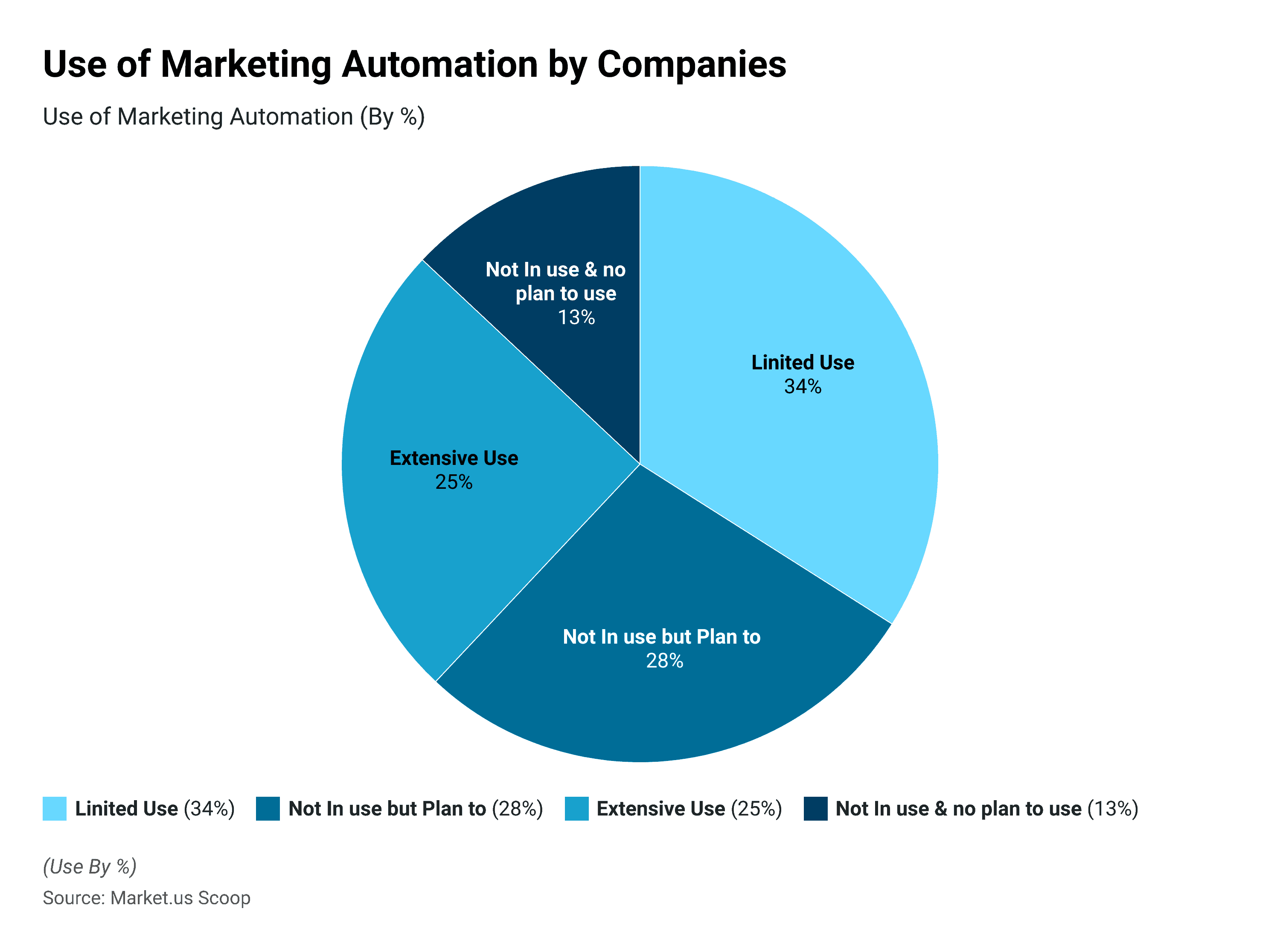
Processes That Make Use of Automation
- Marketing is the most automated business sector.
- 79% of businesses use automation for marketing, 45% for sales, and 33% for finance.
- 26% of those who do not currently use marketing automation intend to do so shortly.
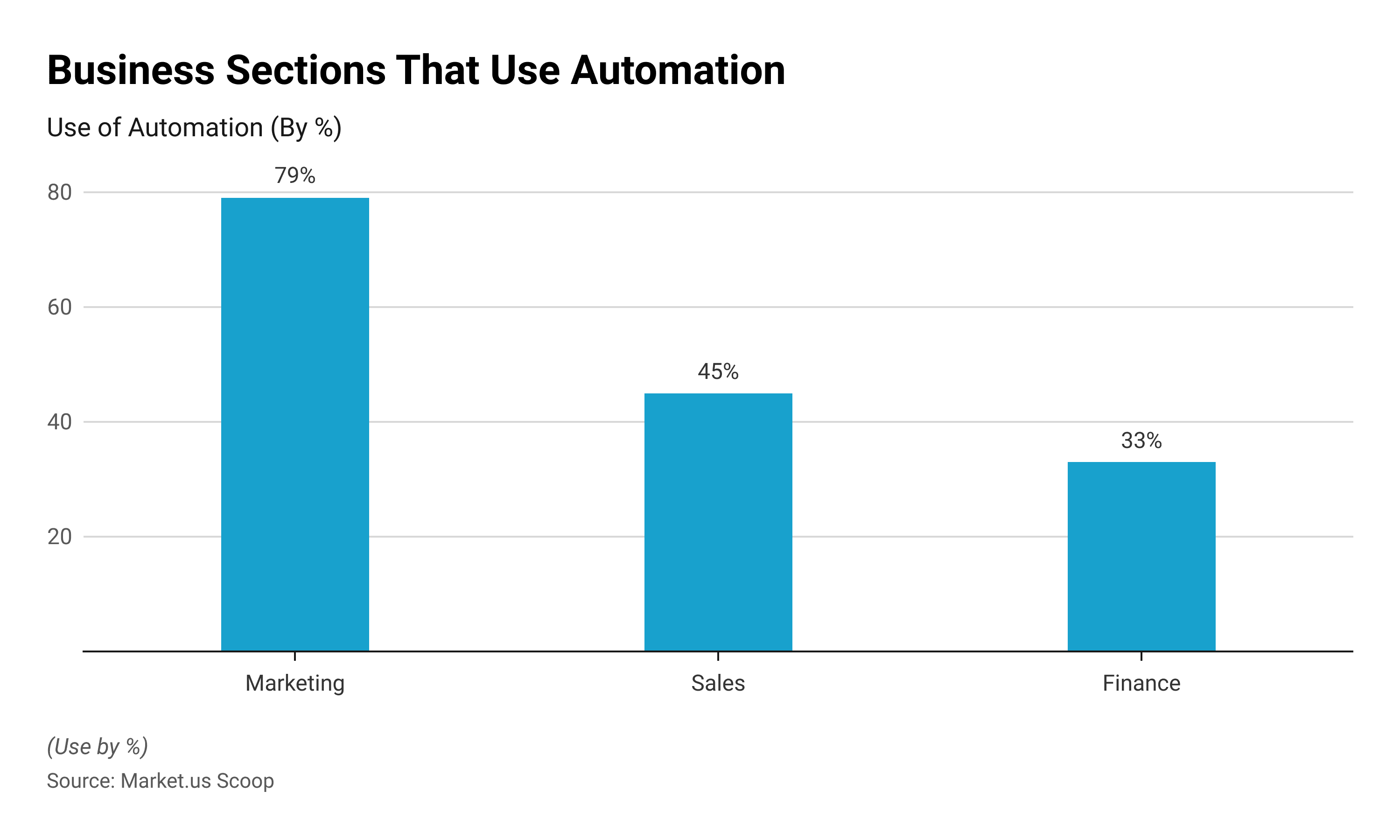
ROI of Marketing Automation
Before you invest in marketing automation, you’ll probably want to know what kind of returns you can expect and when you can expect them.
So, what is the return on investment for marketing automation? Let’s look at some numbers:
- Marketing automation returns $5.44 on every dollar spent in the first three years.
- On average, companies recover the cost of the first investment in automated advertising in less than six months.
- Increased sales productivity, increased campaign efficiency, improved prospect engagement, and cost savings drive marketing automation ROI.
(Source: Nucleus Research)
B2B Marketing Automation
How do B2B companies differ from B2C companies when it comes to marketing automation? Let’s find out.
- In the United States, 59% of B2B marketing professionals believe that actionable analytics and reporting are the most important features to look for when selecting marketing automation software.
- 71% of B2B marketers say automation is used in their email marketing efforts. This is a six-point increase over general marketing professionals.
- In the coming year, 39% of B2B companies plan to implement marketing automation to help with their social media management efforts.
(Source: Statista, B2B & B2C, Act-On)
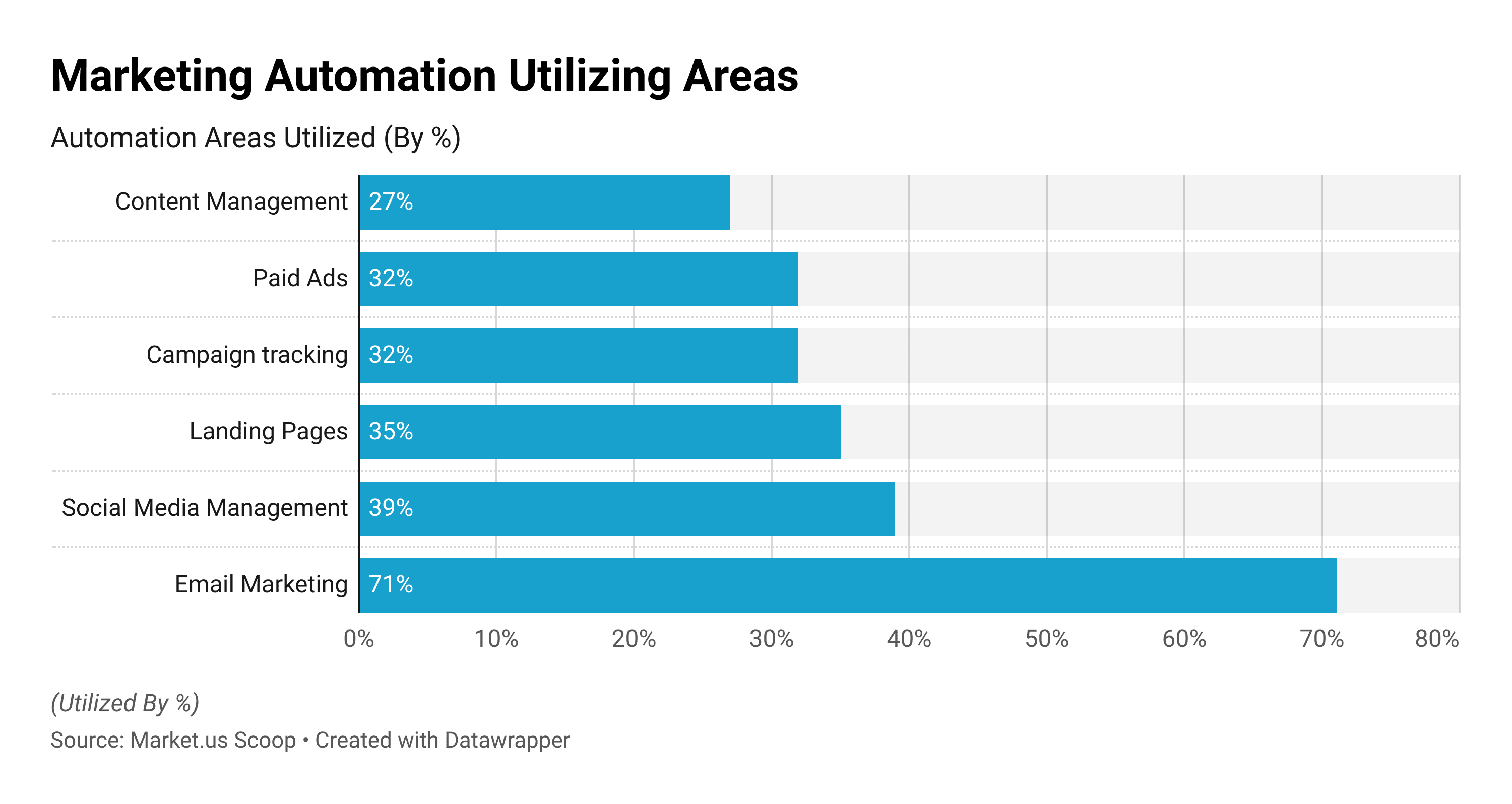
Email Automation
- Statista reports that 50% of SMBs send drip email campaigns using marketing automation software.
- Marketing automation software that sends targeted emails can generate 18 times more revenue compared to general email blasts.
- According to email statistics, segmented and customized automated emails have an average open rate of 46% more than traditional marketing emails. The email opens are the first step to generating revenue.
- GetResponse’s email platform reports that triggered emails have a much higher average open rate (38%) than those sent to an entire list of email addresses (18.7%).
- Welcome emails are the most popular automated emails, according to the same source. They have an open rate of 86%.
- The average open rate for automated cart abandonment emails is 29.64 percent.
- Epsilon reports that triggered emails are opened at a higher rate of 70.5% and clicked on 152% more than standard email newsletters.
- According to the DMA, 75% of email revenues are generated by triggered personalized campaigns, not general campaigns.
- According to the same source, companies that send automated emails are 133% likely to send messages relevant to the stage of a customer’s journey.
Social Media Automation
- Marketing automation software is used by 47% of SMBs to manage social media.
- In 2021, social media will be the second most automated channel – 47% said that they use automation on this channel.
- Again, this is not surprising. According to research, companies can save up to 6 hours per week by automating social media ads and content.
- NapoleonCat calculated that your team could save up to 175 hours per month by automating half of your social media comment moderation using a tool for social media automation. You can use the calculator below to estimate how much your business could save.
- Social media automation is a great help for 64% of marketers who have multiple job duties.
Marketing Automation Trends & Challenges
The #1 goal of marketers is to improve campaign effectiveness.
Professionals who use automation to improve their marketing have as a top priority, 57%, more effective campaigns, and better alignment between marketing and sales. Nearly half (49%) of respondents cited improving the quality of leads as their top priority.
(Source: Ascend2)
Producing high-quality content is a stumbling block for 15% of professionals.
In the 2017 survey, up to 40% of respondents struggled to create high-quality content; the latest figures show an increase in expertise in the creation of content within marketing automation. Most businesses are finding a way to produce high-quality content, whether they rely on in-house advertising teams or work with leading content marketing companies.
(Source: Liana Technologies)
The biggest challenge for 48.6% of marketing and communication professionals was a lack of knowledge.
While many digital marketing companies have implemented marketing automation technologies, others have not for a variety of reasons. Liana Technologies’ marketing automation facts and figures show that a lack of expertise holds nearly half of the respondents back. A lack of human resources was cited by 43.2% of respondents, while a lack of funds was cited by 19%.
(Source: Liana Technologies)
The most common marketing challenge is to create quality automation.
According to statistics from another study, the biggest challenge in marketing automation is creating quality automation. This is the number one barrier to success for 16% of marketing agencies. The next most common challenge in marketing automation is integration. 14% of respondents struggle with this.
Content creation is a major part of this process, and 10% of respondents find it difficult. Another challenge with content is engagement. 8% of respondents have difficulty creating high-quality content people will engage with.
Segmentation, data management, and optimization are common problems for 6% of respondents, while lead scoring, marketing automation, and personalization pose challenges for 5%. 4% of respondents have reported that analytics is a problem, 3% report on the issue, and 1% are concerned about deliverability.
(Source: Automizy)
Chatbot Automation is Used by One-third of Marketers
While task management and post-scheduling are two of the most common uses of tools for automation, automation for sales statistics demonstrates that chatbots have become more common.
Chatbots, when properly developed, can streamline client service processes by categorizing inquiries and directing them to the appropriate staff or assisting new clients in navigating the website.
(Source: HubSpot)
Recent Developments
Acquisitions and Mergers:
- The acquisition of Artifact by Yahoo marks a significant move in the marketing automation landscape. Artifact’s AI-driven technology, designed to enhance content discovery and delivery, will likely bolster Yahoo’s capabilities in delivering more targeted and efficient content to users.
New Product Launches:
- In the realm of marketing automation, significant advancements are being made with AI integration. UiPath, for example, is leading with new automation and AI trends that emphasize the synergy between these technologies. This includes enhancing AI’s role in streamlining tasks and improving operational efficiency across various business functions.
Technological Trends and Strategic Focus:
- There is an increased emphasis on AI and automation use cases that deliver substantial, immediate value. This includes areas like intelligent document processing and automated testing, which are gaining traction due to their significant impacts on productivity and efficiency.
Global Market Trends:
- The focus on digital transformation continues to drive mergers and acquisitions in the marketing automation sector. Companies are increasingly engaging in cross-border collaborations to harness global talent and tap into emerging markets, aiming to drive innovation and access diverse skill sets.
Conclusion
To summarize, marketing automation is a powerful technology that is changing the way businesses approach marketing.
Marketing automation allows businesses to create more personalized, relevant, and effective marketing messages that resonate with their customers by automating repetitive tasks and leveraging data analytics.
Marketing automation is rapidly gaining traction across all industries and regions, with companies of all sizes realizing the benefits of increased efficiency, improved customer engagement, and higher revenue growth.
As technology advances, we can expect to see even more advanced and sophisticated marketing automation tools that leverage AI, machine learning, predictive analytics, and other emerging technologies to help businesses stay ahead of the competition.
FAQ’s
The use of software and technology to automate repetitive marketing tasks such as email campaigns, social media posting, lead generation, and data analysis is known as marketing automation.
Marketing automation has many advantages, including increased efficiency and productivity, improved lead generation and nurturing, better targeting and personalization, and improved analytics and reporting.
Marketing automation works by automating repetitive marketing tasks such as email campaigns, social media posting, and lead generation with software. Email marketing, lead nurturing, lead scoring, analytics, and reporting are common features of this software.
HubSpot is one of the most popular marketing automation tools. Other common ones include Marketo, Pardot Eloqua, and Act-On.
Marketing automation allows marketers to create targeted campaigns delivering personalized content and messages to prospects based on their behavior and interest. This allows you to better build relationships with your prospects and help them move through the sales funnel.
Marketing automation assists with data analysis and report generation by gathering data about marketing campaigns and customer behavior and presenting them in an easy-to-understand and easy-to-use format. Marketers can then make informed decisions about their campaigns, and increase their effectiveness.
Discuss your needs with our analyst
Please share your requirements with more details so our analyst can check if they can solve your problem(s)



